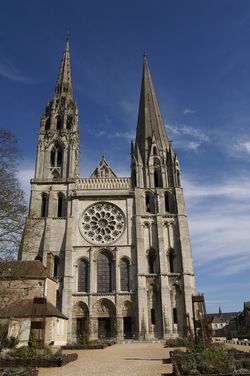Chartres: Difference between revisions
Jump to navigation
Jump to search

imported>Richard Nevell (Created page with "{{subpages}} {{Image|Chartres Cathedral main entrance, 2010.jpg|right|250px|Chartres Cathedral is a World Heritage Site.}} '''Chartres''' is a town in France and a...") |
John Leach (talk | contribs) m (Text replacement - "World Heritage Site" to "World Heritage site") |
||
| Line 1: | Line 1: | ||
{{subpages}} | {{subpages}} | ||
{{Image|Chartres Cathedral main entrance, 2010.jpg|right|250px|[[Chartres Cathedral]] is a [[World Heritage | {{Image|Chartres Cathedral main entrance, 2010.jpg|right|250px|[[Chartres Cathedral]] is a [[World Heritage site]].}} | ||
'''Chartres''' is a town in [[France]] and according to official figures from 2009 it has a municipal population of 39,000.<ref>[http://www.insee.fr/fr/ppp/bases-de-donnees/recensement/populations-legales/commune.asp?annee=2009&depcom=28085 28085-Chartres: Populations légales 2009 de la commune], Institut national de la statistique et des études économiques. Accessed 28 December 2012.</ref> It sits on the [[River Eure]] some 80km south west of [[Paris]].<ref name=Ball16>Ball, Philip (2009). Universe of Stone: Chartres Cathedral and the Triumph of the Medieval Mind. London: Vintage Books. p. 16. ISBN 9780099499442.</ref> There has been human activity in the area since the [[Neolithic]]. In the 2nd century B.C. the settlement was the capital of the Carnutes tribe <ref>[http://www.chartres.fr/decouvrir/histoire-et-patrimoine/histoire-de-la-ville/ Histoire de la ville], Chartres.fr. Accessed 28 December 2012.</ref> The Romans called the town ''Autricum'', derived from their name for the River Eure (''Autura'') but it was also called ''Carnuntum'' after the Carnutes tribe. Christianity probably became the town's main religion sometime in the 4th century A.D. and became the seat of the Bishop of Chartres in the 5th century.<ref name=Ball16/> The present [[Chartres Cathedral|Cathedral at Chartres]] dates from the 12th and 13th centuries and is now a [[UNESCO]] [[World Heritage | '''Chartres''' is a town in [[France]] and according to official figures from 2009 it has a municipal population of 39,000.<ref>[http://www.insee.fr/fr/ppp/bases-de-donnees/recensement/populations-legales/commune.asp?annee=2009&depcom=28085 28085-Chartres: Populations légales 2009 de la commune], Institut national de la statistique et des études économiques. Accessed 28 December 2012.</ref> It sits on the [[River Eure]] some 80km south west of [[Paris]].<ref name=Ball16>Ball, Philip (2009). Universe of Stone: Chartres Cathedral and the Triumph of the Medieval Mind. London: Vintage Books. p. 16. ISBN 9780099499442.</ref> There has been human activity in the area since the [[Neolithic]]. In the 2nd century B.C. the settlement was the capital of the Carnutes tribe <ref>[http://www.chartres.fr/decouvrir/histoire-et-patrimoine/histoire-de-la-ville/ Histoire de la ville], Chartres.fr. Accessed 28 December 2012.</ref> The Romans called the town ''Autricum'', derived from their name for the River Eure (''Autura'') but it was also called ''Carnuntum'' after the Carnutes tribe. Christianity probably became the town's main religion sometime in the 4th century A.D. and became the seat of the Bishop of Chartres in the 5th century.<ref name=Ball16/> The present [[Chartres Cathedral|Cathedral at Chartres]] dates from the 12th and 13th centuries and is now a [[UNESCO]] [[World Heritage site]].<ref>[http://whc.unesco.org/en/list/81 Chartres Cathedral], UNESCO. Accessed 27 December 2012.</ref> | ||
==References== | ==References== | ||
{{reflist}} | {{reflist}} | ||
Revision as of 10:34, 7 March 2024
Chartres is a town in France and according to official figures from 2009 it has a municipal population of 39,000.[1] It sits on the River Eure some 80km south west of Paris.[2] There has been human activity in the area since the Neolithic. In the 2nd century B.C. the settlement was the capital of the Carnutes tribe [3] The Romans called the town Autricum, derived from their name for the River Eure (Autura) but it was also called Carnuntum after the Carnutes tribe. Christianity probably became the town's main religion sometime in the 4th century A.D. and became the seat of the Bishop of Chartres in the 5th century.[2] The present Cathedral at Chartres dates from the 12th and 13th centuries and is now a UNESCO World Heritage site.[4]
References
- ↑ 28085-Chartres: Populations légales 2009 de la commune, Institut national de la statistique et des études économiques. Accessed 28 December 2012.
- ↑ 2.0 2.1 Ball, Philip (2009). Universe of Stone: Chartres Cathedral and the Triumph of the Medieval Mind. London: Vintage Books. p. 16. ISBN 9780099499442.
- ↑ Histoire de la ville, Chartres.fr. Accessed 28 December 2012.
- ↑ Chartres Cathedral, UNESCO. Accessed 27 December 2012.
